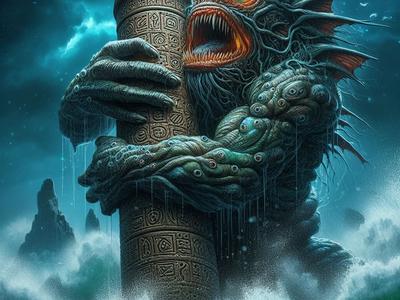The Cthulhu Calendar
Home
·
Blog
Add my event
Dagon: Review

In Dagon, we delve into the terrifying and otherworldly experiences of a man haunted by his encounter with a colossal sea creature. The narrator, a tortured and morphine-addicted man, recounts a harrowing incident that unfolded during his time as an officer in World War I. His cargo ship is commandeered by an Imperial German sea-raider in a remote part of the vast Pacific Ocean. He manages to escape on a lifeboat and drifts aimlessly until he finds himself stranded in a grotesque and slimy black mire.
The narrator speculates that this desolate region was once a part of the ocean floor, brought to the surface through volcanic eruptions. The area is strewn with the decaying corpses of fish and enigmatic beings that protrude from the foul mud. With patience, he waits for three days for the seafloor to dry up enough for him to walk. Finally, he sets out on foot, determined to reach the sea and find potential rescue.
After days of arduous trekking, the narrator stumbles upon a hill that turns out to be the edge of an immense chasm. Descending into the depths, he encounters a monumental white stone object, which he soon recognizes as a meticulously crafted monolith, possibly created by intelligent beings. The monolith stands near a water channel and is covered in hieroglyphs depicting various aquatic symbols. Additionally, crude sculptures adorn the monolith, depicting grotesque humanoid creatures engaging in activities resembling underwater scenes and worship.
As the narrator beholds this eerie sight, a terrifying creature emerges from the water. It rises smoothly to the surface, resembling a monstrous nightmare from the depths of darkness. The creature approaches the monolith, wrapping its colossal scaly arms around it, and emits a series of eerie sounds.
Overwhelmed by fear, the narrator hastily retreats to his stranded boat, and his memories become fragmented. He recollects being rescued by a U.S. ship in the middle of the ocean and waking up in a San Francisco hospital. However, there are no reports of any disturbances in the Pacific region, leaving the credibility of his story in doubt. The narrator recounts an attempt to seek understanding from an ethnologist regarding the ancient Philistine legend of Dagon, the Fish-God. However, the conventional nature of the ethnologist's response dissuades him from pursuing further inquiries.
Plagued by visions of the creature, particularly when the moon is at its waning phase, the narrator expresses his deep-seated fears for the future of humanity. He envisions the nameless horrors lurking in the deep sea, worshipping their ancient stone idols and carving their abominable likenesses on underwater granite obelisks. He dreams of a cataclysmic day when these monstrous beings will rise from the ocean depths to prey upon the remnants of war-weary mankind. The narrator's obsession and despair remain unabated, and with his supply of drugs dwindling, he contemplates taking his own life.
The haunting nature of the story culminates in the chilling revelation that the narrative itself is a suicide note. The article concludes with the narrator hearing an ominous noise at the door, akin to an immense, slippery body lumbering against it. In a panic-stricken plea, he exclaims, "God, that hand! The window! The window!"
In "Dagon: Review", we are confronted with a tale of unimaginable horror, where the boundaries between reality and nightmare blur. The protagonist's descent into madness and his encounter with a monstrous creature from the abyss leave us questioning the fragility of our own existence in the face of unknown and unfathomable forces lurking beneath the waves.